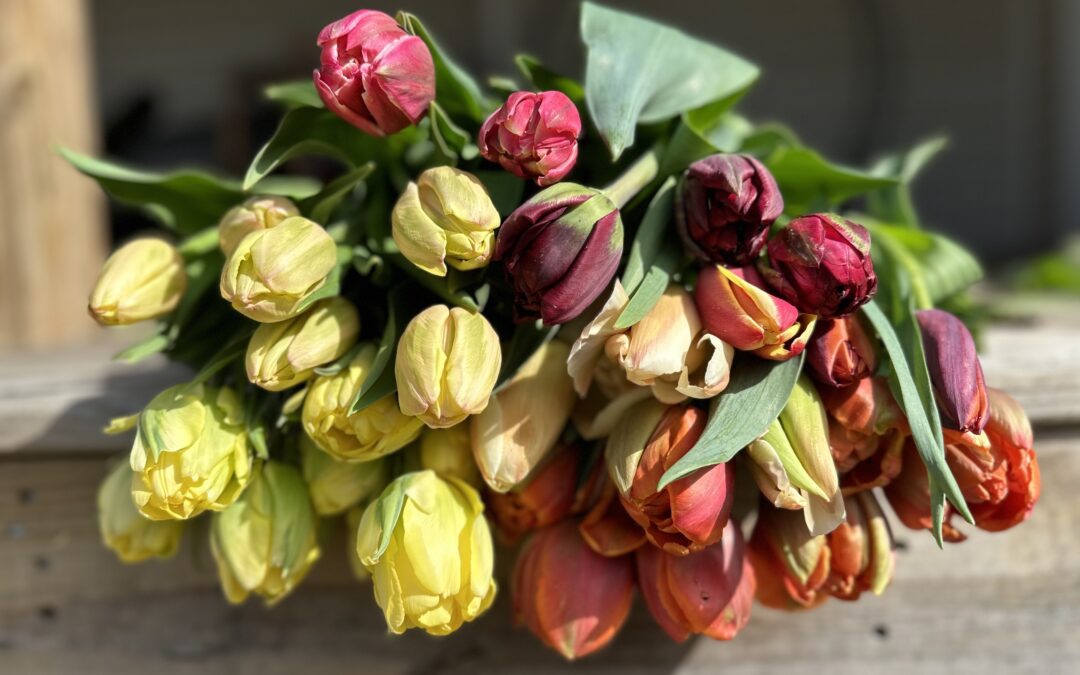Before completely retreating to the comfort of our warm homes, one gardening task that should not be skipped is planting tulips and other spring bulbs. With very little effort, you will reap great rewards in the spring, and your future self will look back and thank you. If you are new to gardening, this is a perfect project to begin your green-thumbed journey, since planting bulbs is not only easy but a highly successful way to grow a beautiful spring garden.
At the very basic level, it’s simply a matter of digging a hole, adding some bulbs, then covering and watering them. After that comes the only difficult step: patiently waiting. While you are snuggled indoors under a warm blanket during the winter months, your bulbs, which are little bundles of energy and potential, will live happily underground, almost forgotten, while preparing for their spring extravaganza.
While tulips are one of my favorite bulbs to plant, squirrels are a challenge, to say the least, because they enjoy them almost as much as I do. And if deer frequent your garden, they will think that you planted a tulip buffet just for them. Though I have found some solutions to critter issues, if you are just starting out, you may want to choose squirrel and deer-resistant flower bulbs. Some great alternatives are daffodils, hyacinths (including grape hyacinths), alliums, snowdrops, and crocuses. Deer will eat almost any plant if they are hungry enough, but many of these bulbs contain toxins that are distasteful to both squirrels and deer. Even without tulips, you won’t be lacking in color. In addition to their signature yellow trumpet flowers, daffodils can be found in cream and white colors, as well as with pink to salmon cups. Hyacinths can be purple, pink, white, lavender, and yellow. Alliums will stand tall with their orbs of purple, pink, white, and burgundy colors. Dainty but tough white and green snowdrops, known in other countries as snow piercers, will push through the snow and give us hope that winter will soon be over.
However, even with these colorful options, I can’t resist tulips. Though I don’t have any deer visiting my garden, squirrels are rampant. Since I love tulips and am up for a good challenge, I have tried different methods to give my tulips a fighting chance. Plant your tulip bulbs deeply to discourage squirrels. After you have covered the hole, cut a square of chicken wire large enough to cover the bulbs, including a border. Then weigh the chicken wire down with a large flat stone or fasten it with landscaping anchor pins. Once the ground freezes, you can remove the chicken wire. You can also interplant your tulips with flowers that deter squirrels, such as daffodils. A tall fence to keep out deer and a spunky dog can also offer some protection. If you successfully grow tulips, you will be wowed by their drama and variety of shapes and colors.
We asked Norah Langweiler of Naked Flower Farm in Egg Harbor Township to offer some of her tulip-growing knowledge. She has already planted 3,300 tulip bulbs on her farm so far this fall. Langweiler shared, “Tulips are one of my favorite crops to grow — not just because I love them (and I do), but also because they are so easy! The great thing about bulbs is the way they hold all the energy and nutrition they need right in the bulb, so there isn’t much need to fertilize (at least not as a flower farmer because we grow them as annuals). And once they are planted (no more than a few inches deep) they don’t need much else.” Langweiler went on to say, “I plant mine in raised beds lined with hardware cloth to keep out voles, moles, and other destructive rodents. The raised beds also prevent the bulbs from rotting in the event of too much rain. As far as any bulb planting, I’d be sure to put them in a spot with good drainage. I know that’s kind of cliche gardening advice, but with bulbs (or tubers like dahlias), it’s especially important because you don’t want them to get too wet and rot in the ground.”
Even if you are not a flower farmer planting thousands of bulbs, you want your flowers to be planted in groups for lovely swathes of color. For the most impact, plant each type of bulb in groups of at least five or more, because a single line of flowers can look sparse. You can also layer your flowers based on height. You might try tiny grape hyacinths in front of the row, daffodils and tulips in the middle, and tall alliums in the back. But consider the bloom schedule. One year, I had a lovely image in my mind of pure white daffodils as a backdrop for bluish-purple hyacinths, only to learn that the daffodils were early bloomers and had faded before the hyacinths had barely bloomed. You can use these different bloom times to your advantage for a long season of spring blooms. Tulips and daffodils can be found in varieties of early, mid, and late blooms. With a little planning, you can have a continuum of color throughout spring.
We would love to hear about your favorite bulbs to plant. Once spring arrives, your buried treasure will reveal itself in all its glory. Send your questions and comments to shorelocalgardener@gmail.com.
Tammy Thornton lives with her husband, children, and crazy pets while enjoying a life of gardening, cooking, and going to the beach.















